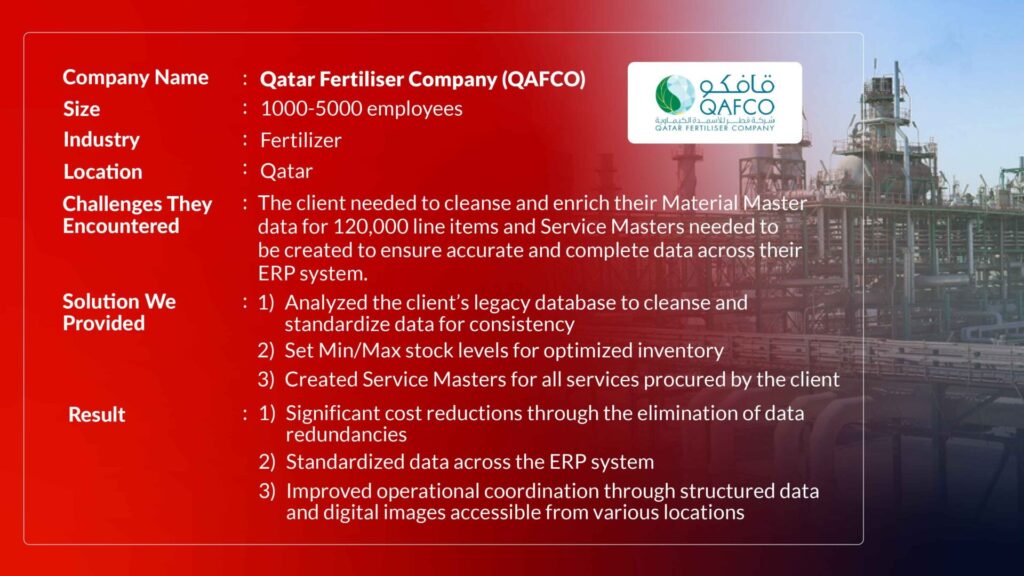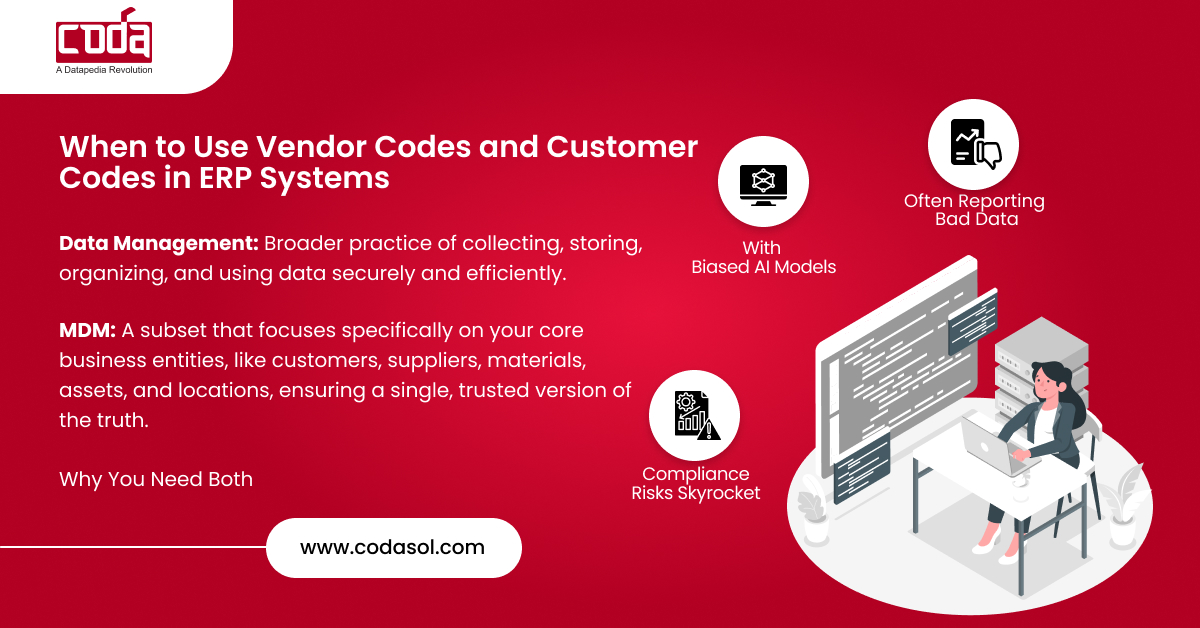Master Data Management vs. Data Management: Key Differences and Why Both Matter
You’re swamped with data. It’s in your ERP, CRM, procurement, spreadsheets, portals, and even paper. Everyone says, “Get your data in order.” But how? Do you need Data Management? Or is it Master Data Management you should invest in?
While Data Management keeps your entire data ecosystem running, Master Data Management (MDM) ensures your most critical data is accurate, unified, and reliable across that ecosystem.
Still sound the same? Not after this read. Let’s break it down with real-world context for fast-paced industries like Oil & Gas, Manufacturing, Real Estate, and Aviation.
Quick Definitions (Because No One Has Time)
- Data Management is the broader practice of collecting, storing, organizing, and using data securely and efficiently.
- Master Data Management is a subset that focuses specifically on your core business entities—like customers, suppliers, materials, assets, and locations—ensuring a single, trusted version of the truth.
Why Should You Care?
If you work in industries where:
- Supply chains stretch across continents,
- Assets worth millions must be tracked,
- Unplanned downtime is a financial disaster,
then dirty or duplicate master data isn’t just annoying, it’s dangerous.
Imagine a gas turbine in the Middle East logged under five different names in your system. Procurement delays. Maintenance errors. Safety risks. That’s what poor master data causes.
Let’s Break It Down: Key Differences
| Feature | Data Management | Master Data Management |
|---|---|---|
| Scope | All types of data | Only core (master) data |
| Goal | Enable storage, security, usage | Ensure accuracy, consistency, and unity |
| Examples | Transaction logs, sensor data, emails | Customer names, part numbers, equipment IDs |
| Tools | Databases, warehouses, BI tools | MDM platforms like PROSOL |
| Outcomes | General analytics & operations | Clean, consistent master data across systems |
Real-World Examples:
1. Oil & Gas (Saudi Arabia)
A downstream refinery had 250,000 line items in their material master. After a master data audit, 18% were duplicates. MDM eliminated redundancies, slashed inventory costs, and improved turnaround planning.
2. Real Estate & Construction (India)
A developer was using multiple CRMs. Each spelled project names and customer data differently. MDM created a golden record, improving customer service and billing accuracy.
3. Healthcare (US)
A hospital network struggled with inconsistent patient data across EHRs. After implementing MDM, they reduced patient matching errors by 40%.
Why You Need Both (Not One Over the Other)
Think of Data Management as building the house and MDM as laying the foundation. Without both:
- You’re reporting on bad data.
- Your AI models are biased.
- Compliance risks skyrocket.
Especially in regulated sectors like banking, healthcare, and defence, a single wrong record can trigger audits, fines, or worse.
Want to assess your current data health? Schedule a 15-minute strategy call with a CODASOL expert.

Common Misconceptions about MDM
“We already have an ERP. Isn’t that enough?”
No. Your ERP is only as good as the data fed into it. ERPs store data; MDM standardizes and governs it.
“We’ll fix it manually later.”
How? When? As data volumes grow, manual cleanup becomes impossible.
“Only large enterprises need MDM.”
False. Even a mid-size EPC contractor in Oman can lose millions annually due to poor master data.
Must-Have Capabilities in an MDM System
- Data deduplication – Eliminate redundant entries across systems.
- Data enrichment – Fill in missing attributes using standards or AI.
- Governance workflows – Set up approvals and version control.
- Integration – Plug into SAP, Oracle, Maximo, or any ERP.
- Reporting – Monitor data quality KPIs in real time.
How to Get Started
Step 1: Audit Your Master Data
Start with material masters, customer records, and assets. How many duplicates? How many fields are incomplete?
Step 2: Define Ownership
Who owns the data—procurement, operations, or IT? Assign stewards.
Step 3: Choose a Purpose-Built MDM Solution
Look for platforms like PROSOL that support multi-language, AI-based cleansing, and ERP integration.
Step 4: Integrate with Your Data Strategy
MDM is not a one-off cleanup. Align it with your data lake, analytics, and digital transformation efforts.
How CODASOL Can Help:
PROSOL, Our End-to-End MDM Platform
At this point, you’re probably thinking,
“This all sounds great, but who’s going to help us actually do it?”
That’s where CODASOL comes in.
We’ve been solving complex data problems across Oil & Gas, Manufacturing, Utilities, EPC, and more for over a decade. Our AI-powered MDM platform, PROSOL, is purpose-built to handle the challenges you face every day:
- Material & asset master cleansing and standardization
- De-duplication, enrichment, and golden record creation
- Seamless integration with ERPs like SAP, Oracle, Maximo
- Governance workflows tailored for operations, procurement, and compliance
- Dashboards that give you real-time visibility into data quality
Whether you’re in India, the GCC, the Far East, or the US, we bring deep domain knowledge and hands-on support to make your MDM journey a success.
Plus: We don’t stop at technology. CODASOL offers full lifecycle services, from data audits and governance design to enrichment and stakeholder training.
Case study

Framework: Data Health Check Template
| Data Entity | Total Records | Duplicates (%) | Missing Fields (%) | Owner | Last Updated |
|---|---|---|---|---|---|
| Materials | 100,000 | 12% | 23% | Procurement | Jan 2025 |
| Vendors | 30,000 | 7% | 18% | Sourcing | Mar 2025 |
| Customers | 50,000 | 10% | 30% | Sales | Feb 2025 |
Use this monthly to track progress.
Final Thoughts: Why It Matters in 2025
You’re no longer managing just data—you’re managing decisions, strategies, and customer trust. In the GCC, Far East, India, and the US—regions with aggressive infrastructure growth and digital goals—good master data is a competitive advantage.
If you’re in:
- Marine & Ports: MDM helps with fleet and asset tracking.
- Healthcare: MDM supports regulatory compliance.
- Aviation: MDM ensures parts tracking and safety compliance.
The future belongs to businesses with clean, controlled, connected data.
Make sure yours is one of them.

Ready to make your data a strategic asset? Explore how PROSOL can help

